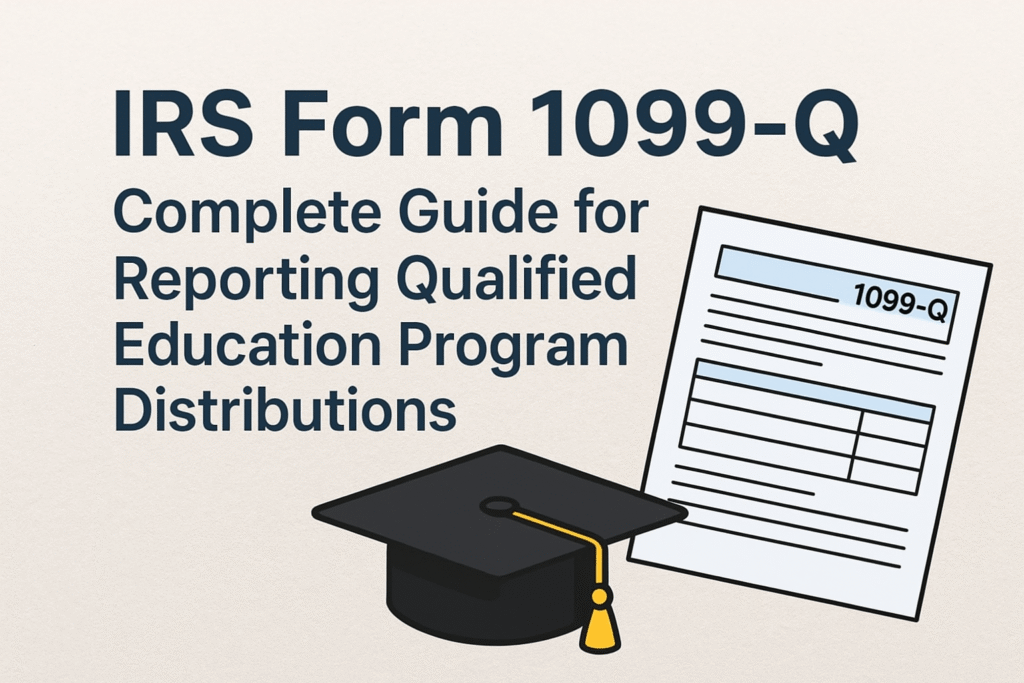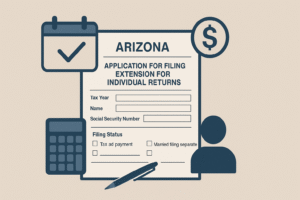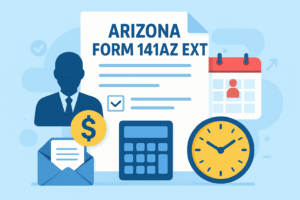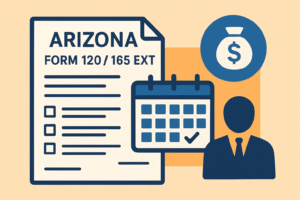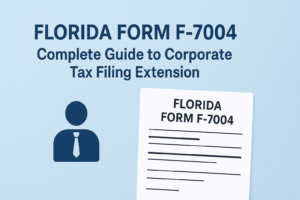Education savings accounts and 529 plans can be powerful tools for paying tuition and other qualified education expenses. However, when funds are withdrawn from these plans, the IRS requires certain reporting to ensure compliance with tax rules. Form 1099-Q, Payments From Qualified Education Programs, is the form used to report distributions from these accounts. Whether you are a plan administrator, custodian, or a recipient, understanding how Form 1099-Q works is essential to avoid mistakes, penalties, and IRS notices.
This comprehensive guide will explain what Form 1099-Q is, who must file it, deadlines, filing procedures, penalties, and more—along with step-by-step form completion instructions.
What Is Form 1099-Q?
Form 1099-Q is an IRS information return used to report distributions from:
- Qualified tuition programs (QTPs), such as 529 college savings plans and prepaid tuition plans.
- Coverdell Education Savings Accounts (ESAs).
The form provides information about the total amount distributed, how much is earnings versus contributions, and the basis for potential taxability. It is sent by the account custodian or program administrator to both the IRS and the recipient of the funds.
The purpose of Form 1099-Q is to help the IRS ensure that distributions are used for qualified education expenses, which may be tax-free, or identify taxable amounts when funds are used for non-qualified purposes.
What Is a Qualified Tuition Program?
A Qualified Tuition Program (QTP), as defined under Section 529 of the Internal Revenue Code, allows taxpayers to either:
- Prepay tuition at eligible educational institutions (Prepaid Tuition Plans), or
- Contribute to an investment account designed to cover qualified higher education expenses (529 College Savings Plans).
Key features include:
- Tax-deferred growth on investments within the account.
- Tax-free withdrawals if used for qualified education expenses (tuition, books, supplies, and in some cases, room and board).
- Flexible beneficiary changes without triggering taxes, as long as the new beneficiary is a qualifying family member.
In addition to 529 plans, Coverdell ESAs also fall under qualified education programs, although they have different contribution limits and age restrictions.
Who Must File Form 1099-Q?
The responsibility to file Form 1099-Q lies with the trustee, custodian, or program administrator of the qualified education program.
Examples:
- If a 529 plan administrator sends funds directly to a student, the administrator files the 1099-Q.
- If a Coverdell ESA custodian makes a distribution, they file the form.
- If the account is rolled over to another QTP or ESA, the administrator handling the distribution files the form, even if the rollover is tax-free.
Recipients themselves do not file the form—they simply receive it and use it for tax reporting.
Who Will Receive Form 1099-Q?
Form 1099-Q is issued to the designated recipient of a distribution from a qualified tuition program (QTP) or a Coverdell Education Savings Account (ESA). The designated recipient is generally:
The Beneficiary (Student)
If the distribution is sent directly to the student or to the educational institution for the student’s benefit, the student is considered the recipient and will get Form 1099-Q.
The Account Owner
If the distribution is sent to the account owner (such as a parent or grandparent who owns the 529 plan or ESA), the account owner is considered the recipient and will receive Form 1099-Q.
Important Notes:
Only one Form 1099-Q is issued per distribution, even if multiple people contributed to the account.
The form reports the total distribution, earnings portion, and basis—it does not separate out the amount used for qualified expenses. The recipient must determine the taxable portion, if any, when filing their tax return.
If the funds were rolled over to another eligible account or beneficiary in a qualified trustee-to-trustee transfer, the form may still be issued, but certain boxes (like Box 4) will be marked to indicate the transfer.
Example:
If a 529 plan owned by a parent sends $10,000 directly to a university for the student’s tuition, the student will receive Form 1099-Q. If instead, the parent requests the $10,000 be sent to their own bank account and then pays the school, the parent will receive the form.
When Is the Deadline to File Form 1099-Q?
The IRS deadlines for Form 1099-Q are:
| Action | Deadline |
| Furnish Copy B to the recipient | January 31, 2026 |
| File with IRS (Paper Filing) | February 28, 2026 |
| File with IRS (Electronic Filing) | March 31, 2026 |
If the due date falls on a weekend or holiday, the deadline moves to the next business day.
What Information Is Required to Complete Form 1099-Q?
To complete Form 1099-Q accurately, you will need:
- Payer’s name, address, and TIN (Taxpayer Identification Number).
- Recipient’s name, address, and TIN.
- Account number (if applicable).
- Total distribution amount.
- Earnings portion of the distribution.
- Basis (contributions) portion of the distribution.
- Program type (QTP or ESA).
Accurate reporting is crucial, as incorrect amounts can trigger IRS inquiries.
How to Complete Form 1099-Q (Line-by-Line Instructions)
Payer Information (Top Left Section)
- Enter the name, address, and TIN of the plan administrator or custodian.
Recipient Information (Top Right Section)
- Enter the recipient’s name, address, and TIN.
Account Number
- Use only if the payer maintains multiple accounts for the same recipient.
Box 1 – Gross Distribution
- Enter the total amount distributed from the account during the year.
Box 2 – Earnings
- Enter the earnings portion of the distribution.
- This may be taxable if used for non-qualified expenses.
Box 3 – Basis
- Enter the amount contributed (principal). This portion is generally not taxable.
Box 4 – Trustee-to-Trustee Transfer
- Check if the entire distribution was a trustee-to-trustee transfer.
Box 5 – Program Type
- Mark 529 plan, Coverdell ESA, or ABLE account (if applicable).
Box 6 – Other Information
- Include any additional IRS-required data.
How to File Form 1099-Q
You can file Form 1099-Q:
- Electronically through the IRS FIRE (Filing Information Returns Electronically) system.
- By paper using Form 1096 as a cover sheet.
Electronic filing is mandatory if submitting 10 or more 1099 forms in a calendar year.
Where to Mail Form 1099-Q
If you prefer paper filing instead of electronic submission, the mailing address for Form 1099-Q depends on the location of your principal business, office, or agency. The IRS uses different processing centers for different states and for filers with foreign addresses. To avoid delays, ensure you use the correct mailing address based on your location as shown in the table below.
| If your business operates in or your legal residence is | Mail Form 1099-Q to |
| Alabama, Arizona, Arkansas, Delaware, Florida, Georgia, Kentucky, Maine, Massachusetts, Mississippi, New Hampshire, New Jersey, New Mexico, New York, North Carolina, Ohio, Texas, Vermont, Virginia | Internal Revenue ServiceAustin Submission Processing CenterP.O. Box 149213Austin, TX 78714 |
| Alaska, Colorado, Hawaii, Idaho, Illinois, Indiana, Iowa, Kansas, Michigan, Minnesota, Missouri, Montana, Nebraska, Nevada, North Dakota, Oklahoma, Oregon, South Carolina, South Dakota, Tennessee, Utah, Washington, Wisconsin, Wyoming | Department of the TreasuryIRS Submission Processing CenterP.O. Box 219256Kansas City, MO 64121-9256 |
| California, Connecticut, District of Columbia, Louisiana, Maryland, Pennsylvania, Rhode Island, West Virginia | Department of the TreasuryIRS Submission Processing Center1973 North Rulon White Blvd.Ogden, UT 84201 |
| Outside the United States | Internal Revenue Service,Austin Submission Processing Center,P.O. Box 149213,Austin, TX 78714 |
What Are the Penalties for Not Filing Form 1099-Q?
The IRS imposes penalties for:
- Late filing.
- Incorrect or incomplete information.
- Failure to furnish the recipient copy.
Penalty amounts for 2025:
- $60 per form if filed within 30 days late.
- $120 per form if filed after 30 days but before August 1.
- $310 per form if filed after August 1 or not filed at all.
Maximum annual penalties can reach millions for large filers.
How to Extend the 1099-Q Deadline
To request more time to file with the IRS:
- File Form 8809, Application for Extension of Time to File Information Returns.
- This provides an automatic 30-day extension.
To extend the recipient copy deadline:
- File Form 15397 with a detailed explanation and proof of hardship.
- Approval is not automatic for recipient extensions.
Exceptions to Filing Form 1099-Q
You do not need to file Form 1099-Q if:
- The distribution is a tax-free trustee-to-trustee transfer.
- The account is transferred to another eligible family member.
- The distribution amount is zero.
What Should Recipients Do with Form 1099-Q?
Recipients should:
- Review the form for accuracy.
- Report taxable amounts (if any) on their federal tax return.
- Keep the form with tax records for at least three years.
If the entire distribution was used for qualified education expenses, no federal income tax is due—but records should be kept in case of an IRS audit.
Conclusion
Form 1099-Q may seem like a simple reporting document, but it plays a significant role in ensuring that education-related savings are used correctly and reported accurately. For plan administrators, timely and accurate filing is key to avoiding penalties. For recipients, understanding the information on the form helps prevent unexpected tax liabilities and supports proper recordkeeping.
By following the filing deadlines, providing complete and correct details, and keeping thorough documentation, both filers and recipients can remain compliant with IRS rules while making the most of qualified education programs.

